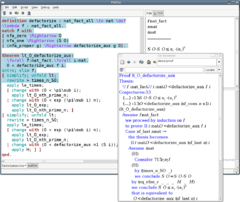Matita
|
| |
|
The Matita proof authoring interface. | |
| Developer(s) | Matita team |
|---|---|
| Initial release | 1999 |
| Written in | OCaml |
| Operating system | GNU/Linux |
| Available in | English |
| Type | Theorem proving |
| License | GPL |
| Website | http://matita.cs.unibo.it |
Matita[1] is an experimental proof assistant under development at the Computer Science Department of the University of Bologna. It is a tool aiding the development of formal proofs by man-machine collaboration, providing a programming environment where formal specifications, executable algorithms and automatically verifiable correctness certificates naturally coexist.
Matita is based on a dependent type System known as the Calculus of (Co)Inductive Constructions (a derivative of Calculus of Constructions), and is compatible, to some extent, with Coq.
The word "matita" means "pencil" in Italian (a simple and widespread editing tool). It is a reasonably small and simple application,[2] whose architectural and software complexity is meant to be mastered by students, providing a tool particularly suited for testing innovative ideas and solutions. Matita adopts a tactic based editing mode; (XML-encoded) proof objects are produced for storage and exchange.
Main features
Existential variables are native in Matita, allowing a simpler management of dependent goals.[3]
Matita implements a bidirectional type inference algorithm[4] exploiting both inferred and expected types.
The power of the type inference system (refiner) is further augmented by a mechanism of hints[5] that helps in synthetizing unifiers in particular situations specified by the user.
Matita supports a sophisiticated disambiguation strategy[6] based on a dialog between the parser and the typechecker.
At the interactive level, the system implements a small step execution of structured tactics[7] allowing a much better management of the proof development, and naturally leading to more structured and readable scripts.
Applications
Matita has been employed in CerCo (Certified Complexity): a FP7 European Project focused on the development of a formally verified, complexity preserving compiler from a large subset of C to the assembler of a MCS-51 microprocessor.
Documentation
The Matita tutorial[8] provides a pragmatic introduction to the main functionalities of the Matita interactive theorem prover, offering a guided tour through a set of not trivial examples in the field of software specification and verification.
See also
References
- ↑ Andrea Asperti, Wilmer Ricciotti, Claudio Sacerdoti Coen, Enrico Tassi. "The Matita Interactive Theorem Prover": CADE-23, LNCS 6803, 2011, pp. 64-69.
- ↑ Andrea Asperti, Wilmer Ricciotti, C Sacerdoti Coen, Enrico Tassi. "A compact kernel for the calculus of inductive constructions": Sadhana 2009, V.34,n.1, pp 71-144
- ↑ Andrea Asperti, Wilmer Ricciotti, C Sacerdoti Coen, Enrico Tassi. "A new type for tactics": Technical Report UBLCS-2009-14. June 2009.
- ↑ Andrea Asperti, Wilmer Ricciotti, C Sacerdoti Coen, Enrico Tassi. "A Bi-Directional Refinement Algorithm for the Calculus of (Co)Inductive Constructions" Logical Methods in Computer Science, V.8,n1
- ↑ Andrea Asperti, Wilmer Ricciotti, C Sacerdoti Coen, Enrico Tassi. "Hints in unification": LNCS V.5674, 2009, pp 84-98
- ↑ Claudio Sacerdoti Coen, Stefano Zacchiroli "Efficient Ambiguous Parsing of Mathematical Formulae" LNCS V.3119, 2004, pp 347-362
- ↑ Claudio Sacerdoti Coen, Enrico Tassi, Stefano Zacchiroli "Tinycals: Step by Step Tacticals" ENTCS V.174, n.2, 2007, Pages 125–142
- ↑ Andrea Asperti, Wilmer Ricciotti, Claudio Sacerdoti Coen "Matita Tutorial" Journal of Formalized Reasoning, V.7,n.2, 2014, Pages 91-199
